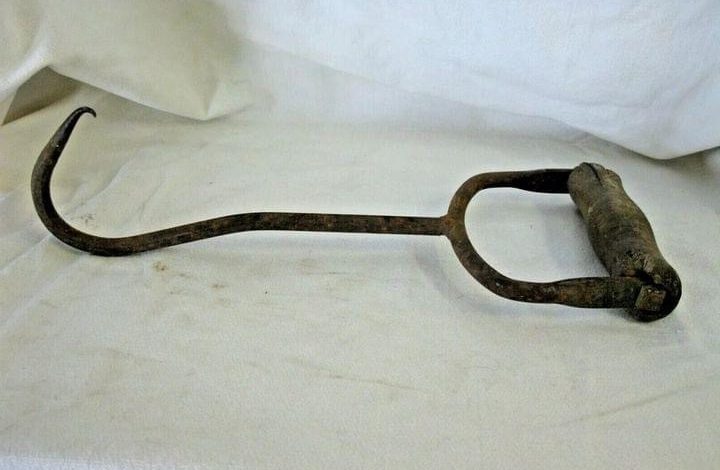The Forgotten Tool: A Journey Through the History and Legacy of the Hay Hook

ADVERTISEMENT
The Forgotten Tool: A Journey Through the History and Legacy of the Hay Hook
Introduction
In the annals of history, tools have played a pivotal role in shaping human civilization. From the simplest stone implements to the most complex machinery, tools have enabled humanity to conquer challenges, build empires, and sustain life. Among these tools, there are some that, while seemingly mundane, have left an indelible mark on the fabric of society. The hay hook, or meat hook, as depicted in the image, is one such tool—a simple yet powerful device that has been instrumental in agriculture, industry, and trade for centuries.
The Origins of the Hay Hook
The hay hook’s origins can be traced back to the early days of agriculture, when humans first began to cultivate and harvest crops on a large scale. As farming practices evolved, so too did the need for tools that could make the work more efficient. The hay hook, with its sturdy design and sharp point, became an essential tool for farmers who needed to move heavy bales of hay, straw, and other materials.
The design of the hay hook is both elegant and practical. A curved metal hook, often with a wooden handle for grip, it was designed to pierce through dense materials and allow the user to lift or drag them with ease. This tool became indispensable in the agricultural community, where it was used daily during harvest seasons. The simplicity of the hay hook’s design belies its effectiveness, making it a staple in barns and fields across the world.
The Evolution of the Hook: From Farms to Butcher Shops
While the hay hook is most commonly associated with agriculture, its design proved so effective that it was adapted for use in other industries, most notably in butcher shops and meatpacking plants. In these settings, the hook was used to lift and move heavy carcasses, aiding butchers in their work. The tool’s ability to handle large, unwieldy objects made it invaluable in environments where strength and efficiency were paramount.
In the meat industry, the hook became a symbol of the trade, representing the hard work and skill required to process animals for food. The hook’s presence in butcher shops was so ubiquitous that it often appeared in signage and advertisements, cementing its place in the cultural imagery of the industry.
ADVERTISEMENT
Cultural Significance and Symbolism
Beyond its practical applications, the hay hook also carries cultural and symbolic weight. In rural communities, where agriculture was the backbone of life, the hay hook was more than just a tool—it was a symbol of the farmer’s labor and perseverance. The sight of a farmer wielding a hay hook, working tirelessly in the fields, became an iconic representation of the agricultural way of life.
In literature and art, the hay hook and similar tools have been used to convey themes of hard work, survival, and the connection between humans and the land. The hook’s rugged appearance and utilitarian design make it a powerful metaphor for the enduring struggle to tame nature and reap its rewards.
The Hay Hook in the Modern World
As agriculture and industry have modernized, the hay hook has largely been replaced by machines and advanced tools that can perform the same tasks more efficiently. However, in some rural areas and traditional settings, the hay hook is still in use, a testament to its durability and effectiveness.
In recent years, there has been a resurgence of interest in vintage tools, including the hay hook. Collectors and enthusiasts seek out these items, not only for their historical value but also for their craftsmanship. The hay hook, once a common tool found in every barn, is now appreciated as a piece of history—a reminder of the ingenuity and hard work of past generations.
Moreover, the hay hook has found new life as a decorative item in homes and businesses that celebrate rustic, farmhouse aesthetics. Mounted on walls or repurposed in creative ways, the hay hook serves as a tangible link to the past, evoking a sense of nostalgia for a simpler time.
ADVERTISEMENT
Lessons from the Hay Hook
The story of the hay hook is one of resilience and adaptation. It is a reminder that even the simplest tools can have a profound impact on the way we live and work. The hay hook’s continued presence in modern culture, whether as a collector’s item, a functional tool, or a decorative piece, speaks to its enduring relevance.
In a world where technology often overshadows tradition, the hay hook stands as a symbol of the value of simplicity and the importance of honoring the tools and practices that have sustained us through the ages. As we look to the future, the hay hook offers a lesson in humility—showing us that sometimes, the most effective solutions are the ones that have been with us all along.
Conclusion
The hay hook, with its humble design and practical purpose, is more than just a tool—it is a piece of history, a cultural symbol, and a testament to human ingenuity. Its journey from the fields of early agriculture to the butcher shops of the industrial era, and finally to its place in modern homes and collections, reflects the ever-changing relationship between humans and their tools.
As we continue to advance and innovate, it is worth taking a moment to appreciate the simple tools that have helped build our world. The hay hook is one such tool, a small yet significant part of our shared heritage, reminding us of the power of human creativity and the enduring spirit of those who work the land.
ADVERTISEMENT




